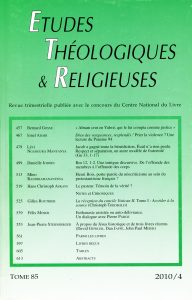Un temps, les chapitres 12-15 de la Lettre aux Romains étaient considérés comme une partie distincte du reste de la lettre. Rm 1-11 était la partie doctrinale et Rm 12 introduisait la partie exhortative. Pourtant, nous explique Danielle Jodoin, des indices discursifs laissent entrevoir que Rm 12, 1-2 marque l’aboutissement d’une intrigue qui se forme tout au long de la lettre. En effet, le « corps », le « culte », l’« intelligence », le « discernement » et la « volonté », présentés négativement en Rm 1-2, reçoivent en Rm 12,1-2 un écho positif. Pour arriver à un tel revirement, divers indices tissent la trame de cette intrigue. Le salut offert en Rm 3, 21-26 rend possible la métamorphose qui inscrit les « membres » et les « corps » dans un processus de transformation (Rm 6-7). Le corps, d’abord disloqué en membres, s’unifie. L’offrande des « membres » conduit alors à l’offrande des « corps » en sacrifice vivant (Rm 12, 1-2) et favorise la communion en rendant les croyants « membres » et « corps » du Christ (Rm 12, 4.5).
Cet article a été présenté lors du Symposium international du RRENAB (Réseau de recherche en analyse narrative des textes bibliques) qui s’est tenu à Montpellier du 15 au 17 mai 2009.
There was a time when chapters 12-15 of the Letter to the Romans were viewed as a separate section of the letter. Romans 1-11 made up the doctrinal section, the parenetic section being introduced in chapter 12. (Some authors even held that Romans 12-15 were not part of the letter!) Danielle Jodoin shows that some discursive clues hint at considering Rom. 12:1-2 as the result of a plot that has been unfolding throughout the entire letter. Indeed, « body », worship », « intelligence », discernment », and « will », which were presented negatively in Rom. 1-2, receive a positive treatment in Rom. 11:1-2. This complete change is made possible because of the various clues which develop the fabric of this plot. It is the salvation offered to all in Rom. 3:21-26 that makes the metamorphosis possible: « members » and « body » are transformed (Rom. 6-7) – a movement takes place such as « members » are no longer subjected to sin but belong to justice. The body, first broken into various members, undergoes a process of reuniting the person (individual level). « Members » gather together into a single body (communal level). The wholeness offering of the « members » thus leads to the offering of the « bodies » in their entirety in a living and holy sacrifice (Rom. 12:1-2) and promotes the communion by making believers « members » and « body » of Christ (Rom. 12:4-5).
p. 499-512
Auteur
JODOIN Danielle
Danielle JODOIN est docteure en études bibliques de l’Université de Montréal.
